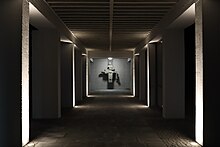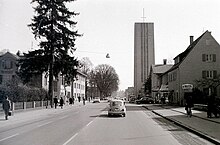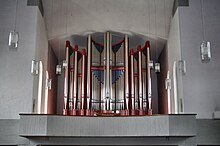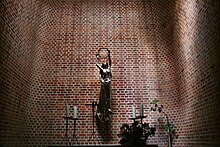Assumption of Mary (Memmingen)
Assumption is a modern Catholic town parish in the Augsburger Strasse to the east of Memmingen .
history
After the Second World War , over 7,000 war refugees and 1,000 Baltic emigrants came to Memmingen. Most found shelter in the east of the city. This made it necessary to build a new Catholic church. The groundbreaking ceremony took place on October 11, 1954. The foundation stone was laid on April 30, 1955 by the Augsburg Bishop Josef Freundorfer . He also consecrated the church after its completion on November 18, 1956. The architect of the building was Thomas Wechs from Bad Oberdorf im Allgäu . The principle of letting all the arts come together in building can be seen in his buildings. He developed a new type of sector church for the church on Augsburger Strasse.
Approach from Augsburger Strasse
If you approach the church from Augsburger Straße , the striking 48.50 meters, with a tower cross 58.50 meters high, immediately catches the eye. The tower cross is an upside down Latin cross, a so-called Petrus cross . In order not to desecrate the upright death of Jesus, Peter had himself crucified upside down. The ground floor of the tower houses the war memorial in the form of a Pietà by Andreas Bindl from Munich. On the console of the figure is written in large Latin letters: Quo vadis ? The Augsburg artist Georg Bernhard created the artistically high quality copper doors for the church.

inner space
The square room is spanned from east to west by two large reinforced concrete arches with a maximum span of 42.50 and a vertex height of 18 meters. In 1974 the church was renovated, brick walls were plastered and an ambo was set up to the side of the altar as part of the liturgical reform . On the south side of the choir is the sacristy and on the north side of the choir there is a Lady Chapel. A candlestick with twelve candles is emblazoned above the altar. They are to remind of the holy city of Jerusalem with the twelve pinnacles. Is unobtrusive in the middle of the altar and obliquely behind the brass plated tabernacle , designed by Therese Hössle-Seidel with the representation of the Last Supper.
organ
The organ comes from the Rieger company (Vorarlberg) and was built in 2004. The instrument has 45 registers on three manuals and a pedal. The game actions are mechanical, the stop actions are electric. The arrangement of the organ is as follows:
|
|
|
|
||||||||||||||||||||||||||||||||||||||||||||||||||||||||||||||||||||||||||||||||||||||||||||||||||||||||||||||||||||||||||||||||||||||||||||||||||||||||||||
- Coupling : II / I, III / I, III / II, I / P, II / P, III / P
Side altars
The side altars were also designed by Georg Bernhard from Augsburg. Eight saints, four at each altar, were depicted with natural stone mosaics. Clothing, attributes and individual face types make them recognizable. Saints Joseph, Anna, Judas Thaddäus and Nicholas are depicted in the northern altar. The Schottenkloster with its Nikolauskirche used to stand opposite today's church. The southern altar shows the canonized Pope Pius X , Niklaus von Flüe , Johann Nepomuk and Saint Hedwig.
A replica of the late Gothic statue of the Redeemer by Ivo Strigel stands on the left in front of the pillars of the organ gallery . The figure shows the risen Christ dressed in gold. The opening in the robe, which allows a view of the wound on the side, is striking. On the right is a protective cloak Madonna from Austria from the 16th century. She is depicted as the protector of the people who seek protection under her cloak.
At the entrance to the choir and organ there is a statue depicting Saint Anthony of Padua .
Lady Chapel
The Marienkapelle is a closed prayer room on the north side of the church. The glass windows show six stations from the life of the Mother of God Mary. In the chapel there is also a baptismal font with a floating dove, symbolizing the Holy Spirit . It says on the lid of the baptismal font:
You are to announce the wonderful deeds of him who called you out of the darkness to his wonderful light. (l Petr 2.9)
The room was designed by Josef Henselmann (1898–1987) from Munich.
literature
- Schnell Hugo: Stadtpfarrkirche Mariä Himmelfahrt Memmingen , Schnell & Steiner, Munich and Zurich 1975.
- Nerdinger Winfried: Thomas Wechs Architect of Modernism. Berlin 2005.
- Bernadette Goebel: Assumption of Mary Memmingen. Josef Fink Verlag, Lindenberg 2006, ISBN 3-89870-374-6 .
Web links
Individual evidence
- ^ Diocese of Augsburg
- ^ Rieger Orgelbau: Parish Church of the Assumption of Mary. Retrieved December 26, 2012 .
Coordinates: 47 ° 59 ′ 13.9 ″ N , 10 ° 11 ′ 24.4 ″ E




